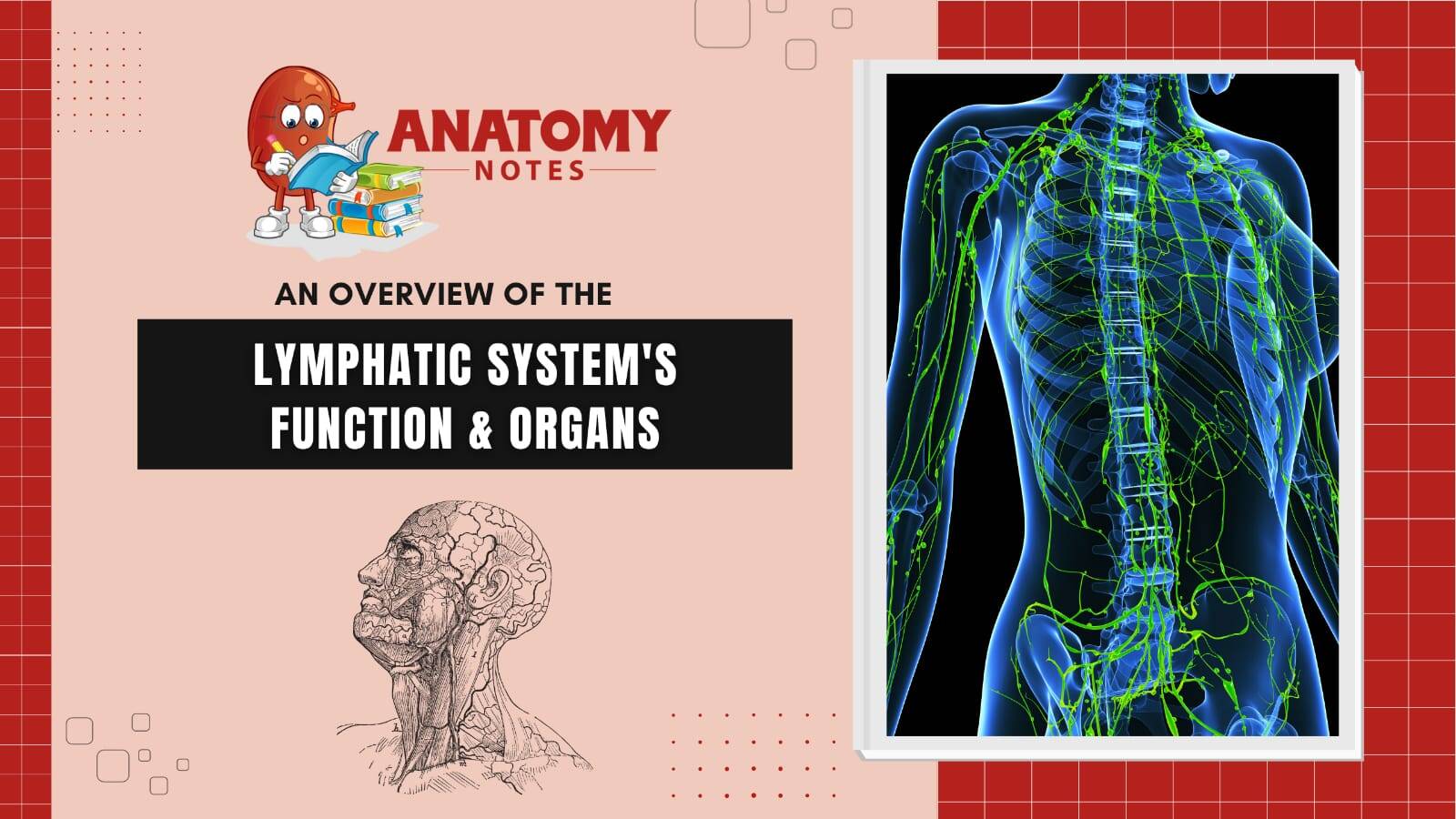The lymphatic system is a vascular network of tubules and ducts that collect, filter and return lymph to blood circulation.
Lymph is a clear fluid that comes from blood plasma, which exits blood vessels at capillary beds.
This fluid becomes the interstitial fluid that surrounds cells. Lymph contains water, proteins, salts, lipids, white blood cells, and other substances that must be returned to the blood.
The primary functions of the lymphatic system are to drain and return interstitial fluid to the blood, to absorb and return lipids from the digestive system to the blood, and to filter fluid of pathogens, damaged cells, cellular debris, and cancerous cells.
Also Read: Skeletal system – Introduction & functions of the skeletal system
Skeletal system – Introduction & functions of skeletal system
Components of the lymphatic system:-
The major components of the lymphatic system include lymph, lymphatic vessels, and lymphatic organs that contain lymphoid tissues.
Lymphatic Vessels
- Lymphatic vessels are structures that absorb fluid that diffuses from blood vessel capillaries into surrounding tissues.
- This fluid is directed toward lymph nodes to be filtered and ultimately re-enters blood circulation through veins located near the heart.
- The smallest lymphatic vessels are called lymph capillaries. Lymphatic capillaries come together to form larger lymphatic vessels.
- Lymphatic vessels from various regions of the body merge to form larger vessels called lymphatic trunks.
- Lymphatic trunks merge to form two larger lymphatic ducts. Lymphatic ducts return lymph to the blood circulation by draining lymph into the subclavian veins in the neck.
Lymph Nodes
- Lymphatic vessels transport lymph to lymph nodes. These structures filter lymph of pathogens, such as bacteria and viruses.
- Lymph nodes also filter cellular waste, dead cells, and cancerous cells. Lymph nodes house immune cells called lymphocytes.
- These cells are necessary for the development of humoral immunity (defense prior to cell infection) and cell-mediated immunity (defense after cell infection).
- Lymph enters a node through afferent lymphatic vessels, filters as it passes through channels in the node called sinuses, and leaves the node through an efferent lymphatic vessel.
Thymus
- The thymus gland is the main organ of the lymphatic system. Its primary function is to promote the development of specific cells of the immune system called T-lymphocytes.
- Once mature, these cells leave the thymus and are transported via blood vessels to the lymph nodes and spleen.
- T-lymphocytes are responsible for cell-mediated immunity, which is an immune response that involves the activation of certain immune cells to fight infection.
- In addition to immune function, the thymus also produces hormones that promote growth and maturation.
Also Read: Endocrine System – Introduction, Structure & Functions
Endocrine System – Introduction, Structure & Functions
Spleen
- The spleen is the largest organ of the lymphatic system. Its primary function is to filter the blood of damaged cells, cellular debris, and pathogens.
- Like the thymus, the spleen houses and aids in the maturation of lymphocytes. Lymphocytes destroy pathogens and dead cells in the blood.
- The spleen is rich in the blood supply via the splenic artery. The spleen also contains efferent lymphatic vessels, which transport lymph away from the spleen and toward lymph nodes.
Tonsils
- Tonsils are arrays of lymphatic tissue located in the upper throat region. Tonsils house lymphocytes and other white blood cells called macrophages.
- These immune cells protect the digestive tract and lungs from disease-causing agents that enter the mouth or nose.
Bone Marrow
- Bone marrow is the soft, flexible tissue found inside the bone. Bone marrow is responsible for the production of blood cells: red blood cells, white blood cells, and platelets.
- Bone marrow stem cells play an important role in immunity as they generate lymphocytes.
- While some white blood cells mature in bone marrow, certain types of lymphocytes migrate to lymphatic organs, such as the spleen and thymus, to mature into fully functioning lymphocytes.
- Lymphatic tissue can also be found in other areas of the body, such as the skin, stomach, and small intestines.
- Lymphatic system structures extend throughout most regions of the body. One notable exception is the central nervous system.
Functions of the lymphatic system:-
The lymphatic system has 3 main functions:
- It maintains the balance of fluid between the blood and tissues, known as fluid homeostasis.
- It forms part of the body’s immune system and helps defend against bacteria and other intruders.
- It facilitates the absorption of fats and fat-soluble nutrients in the digestive system.
Frequently Asked Questions (FAQs)
Which organ is the primary component of the lymphatic system?
The main organ of the lymphatic system is the lymph node. Lymph nodes are small, bean-shaped structures that are located throughout the body and contain immune cells that help to filter and trap foreign substances, such as bacteria and viruses, from the lymphatic fluid.
What are the 7 primary components of the lymphatic system?
The 7 main parts of the lymphatic system are:
- Lymph nodes: Tiny structures that resemble beans in shape and are responsible for filtering lymphatic fluid.
- Lymphatic vessels: Tubes that transport lymphatic fluid throughout the body.
- Thymus: A gland located in the chest that produces and matures T-cells, a type of immune cell.
- Spleen: An organ located in the abdomen that filters blood and helps to remove old or damaged red blood cells.
- Bone marrow: A spongy tissue located inside bones that produces blood cells, including white blood cells important for immune function.
- Tonsils: Clusters of lymphoid tissue located at the back of the throat that help to protect against infections.
- Peyer’s patches: Small masses of lymphoid tissue located in the wall of the small intestine that help to protect against pathogens and toxins.
Which is largest lymphatic organ?
The spleen holds the distinction of being the biggest lymphoid organ in the human body. It is located in the upper left part of the abdomen and is about the size of a fist. The spleen plays an important role in filtering blood and removing old or damaged red blood cells, as well as helping to fight infections by producing and storing immune cells such as lymphocytes and monocytes.
What are the 4 main functions of the lymph?
The four main functions of lymph are:
- Drainage: Lymph collects excess fluid, proteins, and waste products from the tissues and returns them to the bloodstream through lymphatic vessels.
- Immune defense: Lymph contains white blood cells called lymphocytes that help to defend against infections by identifying and attacking foreign substances such as viruses and bacteria.
- Lipid absorption: Lymphatic vessels in the small intestine absorb dietary fats and fat-soluble vitamins and transport them to the bloodstream.
- Tissue repair: Lymphatic vessels play a role in tissue repair by delivering nutrients and oxygen to damaged tissues and removing cellular waste products.
Which is not a main function of the lymphatic system?
The lymphatic system does not have the main function of producing hormones. While the lymphatic system plays a critical role in many functions of the body, including immune defense, fluid balance, and lipid absorption, hormone production is not one of its primary functions. Hormone production is primarily the responsibility of the endocrine system.
Where is the lymph located?
Lymph is located throughout the lymphatic system, which includes lymphatic vessels, lymph nodes, and other lymphoid organs such as the spleen and thymus gland. Lymphatic vessels and lymph nodes are found throughout the body, including in the skin, mucous membranes, digestive system, respiratory system, and reproductive system. The lymphatic system is interconnected with the circulatory system, and lymphatic vessels often follow the path of blood vessels.




